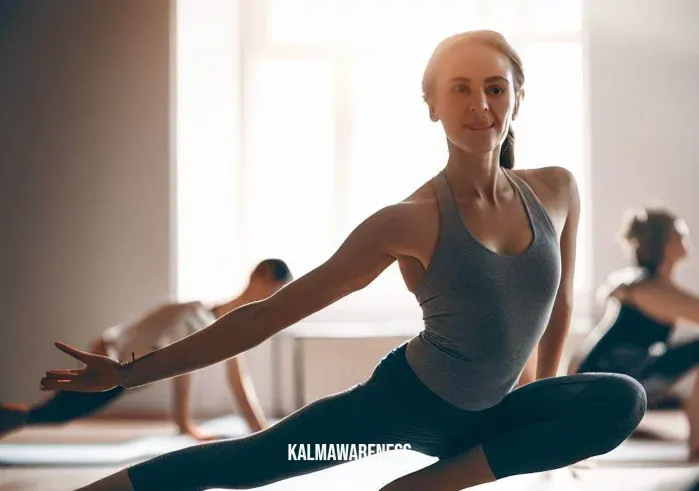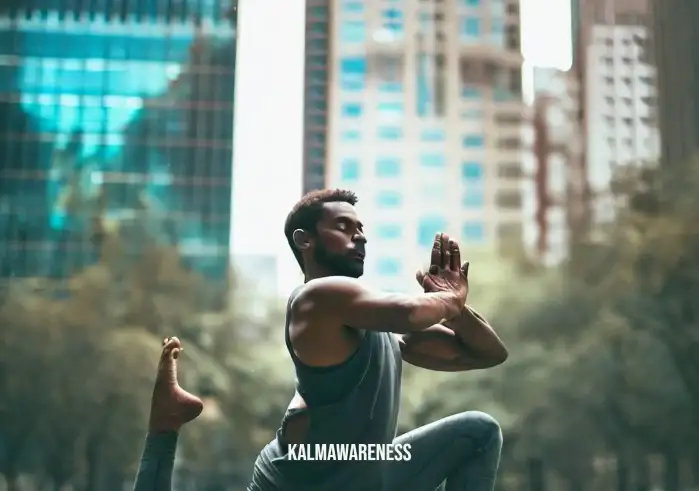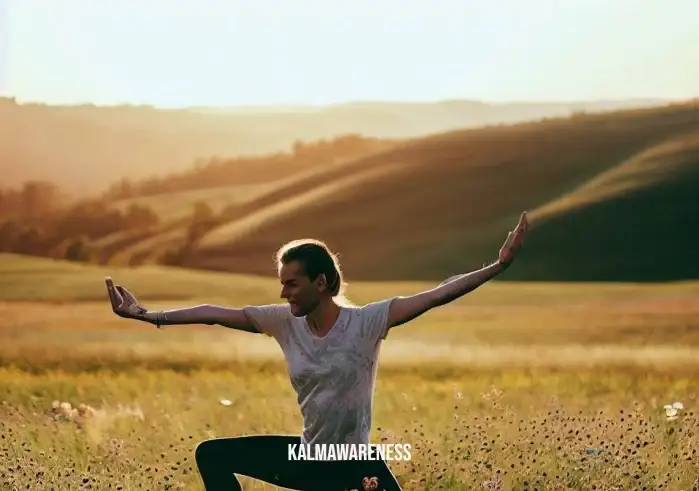Yoga Pose: Side Crow Yoga Pose
Meta Title: Mastering Side Crow Yoga Pose for Strength and Balance
Welcome to the first part of our comprehensive guide on Side Crow Yoga Pose. In this series, we will explore the benefits, variations, and step-by-step instructions to help you master this challenging yet invigorating yoga pose. Get ready to enhance your strength, balance, and focus as we dive into the world of Side Crow Yoga Pose!
Pose Details
| Description | Explanation |
|---|---|
| Pose Name | Side Crow Yoga Pose |
| Original Name | Parsva Bakasana |
| Difficulty Level | Intermediate |
| Pose Category | Arm Balance |
| Exercise Duration | Beginners: 30-60 seconds<br>Advanced: 1-2 minutes |
Overview and Benefits
Side Crow Yoga Pose, or Parsva Bakasana, is an arm balancing pose that challenges your core strength, arm stability, and focus. It is a variation of the traditional Crow Pose and offers additional benefits, including:
- Core Strengthening: Side Crow Yoga Pose targets your abdominal muscles, obliques, and deep core stabilizers, helping you develop a strong and toned midsection.
- Arm and Shoulder Strength: By bearing the weight of your body on your hands and arms, this pose engages your arm and shoulder muscles, building strength and stability.
- Balance and Coordination: As you balance on your hands while twisting your torso, Side Crow Yoga Pose improves your overall balance and body coordination.
- Concentration and Focus: Achieving and holding this challenging pose requires mental focus and concentration, promoting mindfulness and clarity of mind.
In the next part of this series, we will delve into the preparatory poses and warm-up exercises that will help you build the necessary strength and flexibility for Side Crow Yoga Pose. Get ready to embark on your yoga journey towards mastering this empowering pose!
Stay tuned for Part 2: Preparatory Poses and Warm-up Exercises for Side Crow Yoga Pose

Exploring the Benefits, Modifications, and Precautions of Side Crow Yoga Pose
Welcome to the second part of our comprehensive guide on Side Crow Yoga Pose. In this chapter, we will delve deeper into the incredible benefits of this pose, modifications for different levels of experience, and precautions for those who may need to approach this pose with caution. Let’s continue our journey towards mastering Side Crow Yoga Pose and unlocking its full potential.
Benefits of Side Crow Yoga Pose
Side Crow Yoga Pose offers a wide range of physical, mental, and energetic benefits. Let’s explore how practicing this pose can positively impact your well-being:
- Strengthens the Upper Body: Side Crow Yoga Pose is a powerhouse for building upper body strength. It targets the arms, wrists, shoulders, and core muscles, helping you develop stability and toning your upper body.
- Improves Digestion: The twisting motion involved in Side Crow Yoga Pose stimulates the abdominal organs, aiding digestion and promoting a healthy digestive system.
- Enhances Balance and Coordination: Balancing on your hands while twisting your body requires a high level of concentration and body awareness. Regular practice of Side Crow Yoga Pose improves your balance and coordination skills both on and off the mat.
- Boosts Confidence and Mental Focus: Mastering Side Crow Yoga Pose can be a challenging journey. As you progress and achieve this pose, it boosts your self-confidence and enhances your mental focus, cultivating a sense of achievement and empowerment.
- Develops Core Strength: Side Crow Yoga Pose activates the deep core muscles, including the obliques and transverse abdominis. Strengthening these muscles enhances stability, improves posture, and supports your overall yoga practice.
Modifications and Variations
Side Crow Yoga Pose can be modified to accommodate practitioners of different levels of experience. Here are some variations to explore:
- Beginner Modification: If you’re new to Side Crow Yoga Pose, you can start by practicing a modified version known as the Supported Side Crow. Place a block or bolster in front of you, resting your forehead on it as you lift one leg at a time into the side twist. This modification provides additional support and stability while you build strength and balance.
- Advanced Variation: For those seeking an additional challenge, you can explore the One-Legged Side Crow variation. Instead of both feet lifting off the ground, keep one foot grounded while extending the other leg straight out. This variation requires greater core and arm strength, as well as increased focus and balance.
- Props for Stability: If you find it challenging to balance on your hands, you can use props like yoga blocks or blankets for added support. Place the props under your hands to elevate the ground and reduce the strain on your wrists.
Precautions and Who Should Avoid Side Crow Yoga Pose
While Side Crow Yoga Pose offers numerous benefits, it may not be suitable for everyone. It is important to practice with caution and avoid this pose if you:
- Wrist or Shoulder Injuries: Individuals with wrist or shoulder injuries should avoid Side Crow Yoga Pose as it places a significant amount of weight on these areas. It’s important to prioritize your safety and work on healing before attempting this pose.
- Pregnancy: Pregnant individuals should avoid intense abdominal twists like Side Crow Yoga Pose. It is essential to consult with a qualified prenatal yoga instructor for appropriate modifications and guidance during pregnancy.
- High Blood Pressure: If you have high blood pressure or any heart-related conditions, it is advisable to avoid inversions and intense arm balances, including Side Crow Yoga Pose. These poses can increase blood pressure and may not be suitable for individuals with these health concerns.
Always listen to your body, respect its limits, and seek guidance from a certified yoga instructor if you have any concerns or specific conditions.
In the upcoming chapter, we will focus on the alignment and step-by-step instructions to help you safely practice Side Crow Yoga Pose. Get ready to explore the intricacies of this pose and refine your technique for a graceful and empowering experience.
Continue to Part 3: Step-by-Step Instructions and Alignment Tips for Side Crow Yoga Pose

Unveiling the History, Spiritual Significance, and Tips for Mastery
Welcome to the third part of our comprehensive guide on Side Crow Yoga Pose. In this chapter, we will dive into the rich history of this pose, explore its spiritual significance, provide valuable tips to enhance your practice, highlight common mistakes to avoid, and suggest complementary poses that can enrich your yoga journey. Let’s continue our exploration of Side Crow Yoga Pose and deepen our understanding of its multifaceted nature.
The History of Side Crow Yoga Pose
Side Crow Yoga Pose has its roots in the ancient practice of yoga. While specific records of its origin are not readily available, it is believed to be an evolution of the traditional Crow Pose (Bakasana). Over time, variations and modifications have emerged, leading to the development of Side Crow Yoga Pose as we know it today.
Spiritual Significance of Side Crow Yoga Pose
In addition to its physical benefits, Side Crow Yoga Pose holds spiritual symbolism within the realm of yoga. It is often associated with the Manipura (Solar Plexus) chakra, which represents personal power, transformation, and willpower. Practicing Side Crow Yoga Pose can help stimulate and balance the Manipura chakra, allowing energy to flow freely and fostering a sense of personal empowerment and self-mastery.
Tips for Getting the Most out of Side Crow Yoga Pose
To optimize your practice and experience the full potential of Side Crow Yoga Pose, consider the following tips:
- Build Core Strength: Strengthening your core muscles is essential for achieving stability in Side Crow Yoga Pose. Incorporate core-focused exercises into your regular yoga routine to develop the necessary strength and support.
- Focus on Arm Stability: Proper alignment and engagement of the arms are crucial for maintaining balance and ease in this pose. Root your hands firmly into the ground, spread your fingers wide, and engage the muscles of your arms to create a solid foundation.
- Twist with the Breath: As you initiate the twist in Side Crow Yoga Pose, synchronize your movements with your breath. Exhale as you twist and draw your knees toward your upper arm, allowing your breath to guide you deeper into the pose.
- Maintain a Soft Gaze: Instead of fixating your gaze on the floor, shift your focus slightly forward, allowing your gaze to be soft and steady. This helps in maintaining balance and a sense of inner calm.
Common Mistakes to Avoid
To ensure a safe and effective practice of Side Crow Yoga Pose, be mindful of these common mistakes:
- Collapsing the Chest: Avoid collapsing the chest or rounding the upper back. Keep your chest lifted and broad, creating space for the twist and maintaining proper alignment.
- Gripping the Mat: Excessive gripping or tensing of the hands can restrict the flow of energy and limit your stability. Instead, focus on grounding your hands while maintaining a sense of lightness and ease.
- Forcing the Pose: Avoid pushing yourself into the full expression of Side Crow Yoga Pose without proper preparation. Progress gradually, honoring your body’s limits and giving yourself time to develop the required strength and flexibility.
Modifications for Injuries or Limited Flexibility
For individuals with injuries or limited flexibility, modifications can make Side Crow Yoga Pose more accessible and safe. Here are some variations to consider:
- Knee-to-Arm Balance: Instead of lifting both feet off the ground, focus on balancing one knee on the upper arm while keeping the other foot grounded. This modification reduces strain on the wrists and provides stability.
- Support with Blocks: Place yoga blocks under your hands or forearms to elevate the ground, providing additional support and stability as you work on building strength and confidence.
Complementary Poses
To further deepen your practice and enhance the benefits of Side Crow Yoga Pose, consider integrating these complementary poses into your yoga routine:
- Boat Pose (Navasana): Boat Pose strengthens the core and hip flexors, offering support for Side Crow Yoga Pose.
- Twisted Chair Pose (Parivrtta Utkatasana): Twisted Chair Pose helps improve spinal mobility and strengthens the core, preparing you for the twist in Side Crow Yoga Pose.
- Revolved Triangle Pose (Parivrtta Trikonasana): Revolved Triangle Pose opens the hips and stretches the spine, complementing the twisting action of Side Crow Yoga Pose.
As we conclude this chapter, you are now equipped with a deeper understanding of the history, spiritual significance, tips for mastery, common mistakes to avoid, modifications for different needs, and complementary poses to explore alongside Side Crow Yoga Pose. In the next part of our series, we will delve into the step-by-step instructions and alignment cues to guide you through this empowering pose.




